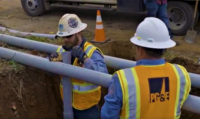California utility Pacific Gas and Electric Co. (PG&E) is facing fierce backlash from customers and government officials after executing a fire-risk mitigation plan that preemptively shut off power for several days to 730,000 account holders in the state’s northern area that affected up to 2 million people.
The move sparked new fears about the bankrupt company’s increasing liabilities and its ability to promptly pay creditors billions owed.
William Johnson, a veteran utility executive who joined PG&E this year, admitted to state regulators at an Oct. 18 emergency meeting the shutoff execution flaws but said the action was effective in preventing a major fire.
He outlined other pre-emptive system fixes under way, but said power shutdowns would continue to some degree for the next decade.
Johnson sparred with regulators, and state and local officials over a range of PG&E issues, from who should control fire-risk power shutdown decisions to municipalities' push to take over some grid systems and infrastructure.
Meanwhile, the utility says on its website that no shutdown were set for the week of Oct. 20.
PG&E and its parent company PG&E Corp., serving 16 million people in northern and central California, declared bankruptcy earlier this year after the utility was faulted for sparking the November 2018 Camp Fire in Paradise, Calif., which killed at least 85 people and destroyed nearly 19,000 buildings.
This summer, California created new requirements to measure PG&E’s safety improvements and management through California Public Utilities Commission (CPUC) oversight of a wildfire mitigation plan, which allows its approved Public Safety Power Shutoffs in certain weather-related events.
Between Oct. 9 and 13, PG&E implemented its seventh and largest shutdown after the National Weather Service issued red-flag fire warnings due to dry conditions, hot weather and winds throughout the state. PG&E began the shutdown program in 2018, with its first activation last October.
But state officials say the utility’s latest execution of its mitigation plan failed to adequately communicate with the public, coordinate with government agencies and restore power in a reasonable time frame.
'Unacceptable'
Gov. Gavin Newsom (D) called PG&E’s shut-down effort “unacceptable,” and the company admits the outage did not go as expected.
“We do know that some things didn’t work as well as we wanted to — specifically the website,” says spokesperson Jeff Smith, who attributes PG&E’s lack of communication to inadequate bandwidth for high volume traffic for its website, which crashed, and call center backlog, leaving customers without access to any information on power restoration.
“The scope, scale, complexity, and overall impact to people’s lives, businesses, and the economy of this action cannot be understated,” said Marybel Batjer, CPUC president, in a letter to PG&E CEO William Johnson that issued a seven-point directive ordering PG&E to immediately address failures.
He responded in an Oct. 17 letter noting planned improvements by the utility, particularly to its communication system, that “events such as these cannot become the status quo in California.”
Despite the havoc, area construction projects appeared to sustain minimal impacts during the power outage.
Mark Breslin, CEO of United Contractors, which represents regional heavy civil contractors, says the outages affected some members’ offices, but most field operations continued.
The Northern California chapter of the Associated Builders and Contractors Inc. (ABC NorCal) said members in affected areas reported only minor delays.
“Since these blackouts are new and unique, ABC and their members are still in discussion on how to prepare if they continue to happen,” says Nate Haderlie, spokesperson for ABC NorCal.
PG&E said that a crew of 6,300, including company employees and contractors, worked the latest shutdown. The utility would not confirm the percentage outsourced to contracted workers, which included engineers, general contractors and craft workers called in to help restore power, or the percentage of those workers from out-of-state. The utility also would not speculate on the funding amount to be appropriated for outsourcing additional work.
READ FORBES VIEWPOINT
Disruptors Wanted: PG&E Shows Why Infrastructure Innovation Is Imperative
The CPUC letter directs the utility to develop a list of existing and possible future on-call consultants and resources in case of an emergency.
“PG&E must take steps to have resources of various capabilities available in order to scale a response and assist with problem solving,” said Batjer. “This could, for example, involve standing contracts with a range of technical experts and general consultants who are available to step-in and manage issue resolution.”
Chapter 11 Woes
Meanwhile, PG&E faces criticism over bankruptcy claimant compensation.
The utility’s reorganization and repayment plan estimates debt over $20 billion, with $12 billion for claimants and $8.4 billion for fire victims.
Claimants say the cost is closer to $29 billion, and bankruptcy court Judge Dennis Montali on Oct. 9 stripped PG&E of its exclusive right to submit a reorganization of its debt, which allows consideration of an alternate plan led by bondholders and fire victims.
Previously opposed to competing plans, "fearing a windfall for lawyers and accountants," he said in a letter, noting that his changed position comes "in light of the looming deadline" for meeting the June 30, 2020 deadline for PG&E to exit bankruptcy to gain access a new wildfire mitigation fund set up to help it and other utilities cover costs.
Montali noted "significant progress" by PG&E on its bankruptcy plan, which he said "is on track as well as can be expected for now."
But UBS analysts noted in an Oct. 10 report that “Judge Montali's decision to eliminate exclusivity means more voices and more of a governance debate upcoming."
PG&E was disappointed that the court opened the door on a plan “designed to unjustly enrich Elliott and the other ad hoc bondholders and seize control of PG&E at a substantial discount." an official told ENR.
“We are confident that our fully funded plan of reorganization, which will satisfy all wildfire claims in full while treating all stakeholders fairly and protecting customers, is the better solution for all constituencies and will be confirmed,” says Ari Vanrenen, spokesperson for PG&E.
Turner Construction, which estimates it is owed $20 million, said it believes in its claims’ strengths and will proceed with the claims process, says Turner executive vice president Mike Kuntz.
ENR previously reported Turner’s work included mission-critical energy grid upgrades performed before the filing under a construction services agreement. In an earlier filing, Turner said its claims are secured by “constitutional and statutory liens” that favor the firm.
PG&E has been prompt in repaying post-bankruptcy debts to contractors, according to Breslin, but UCON members are realistic and pragmatic about repayment of pre-bankruptcy debts, which he expects at a “glacial pace” as claims weave their way through court.
“PG&E has been quick to making contractors whole because capital leverage was creating hardship for some PG&E contractors who they do work with,” says Breslin. “They understood the cash flow hardship to wait for the court pre-bankruptcy.”
The bar date for all PG&E Chapter 11 claims cases must be filed by Oct. 21 and applies to all claims against PG&E that happened before Jan. 29, including those of loss or injury from the Northern California fires.
“What are you going to do to increase resources from the construction industry?” Breslin asks. “It’s going to happen again.”
Earlier this week, the utility said it is adding two members to its board: Bill Smith, retired president of AT&T Technology Operations at AT&T Services Inc.; and John Woolard, CEO of Meridian Energy and a senior operating partner at Activate Capital.





Post a comment to this article
Report Abusive Comment